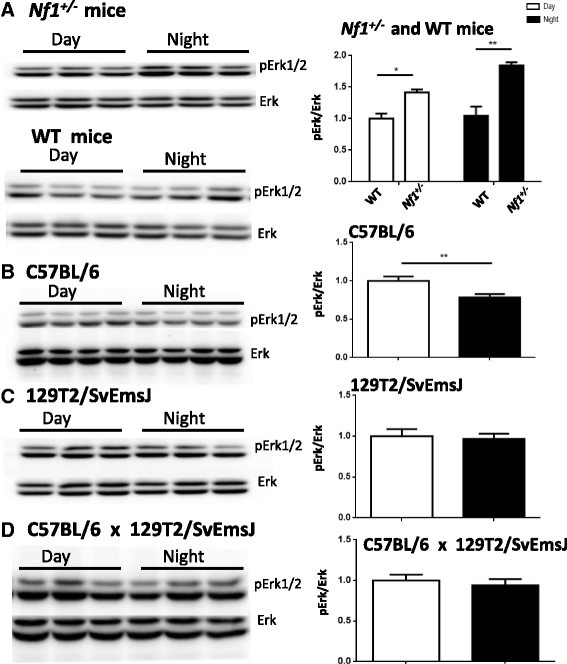Abnormal circadian oscillation of hippocampal MAPK activity and power spectrums in NF1 mutant mice
- PMID: 28673309
- PMCID: PMC5496334
- DOI: 10.1186/s13041-017-0309-8
Abnormal circadian oscillation of hippocampal MAPK activity and power spectrums in NF1 mutant mice
Abstract
Studies have implied that the circadian oscillation of mitogen-activated protein kinase (MAPK) signal pathways is crucial for hippocampus-dependent memory. NF1 mouse models (Nf1 heterozygous null mutants; Nf1 +/-) displayed enhanced MAPK activity in the hippocampus and resulted in memory deficits. We assumed a link between MAPK pathways and hippocampal rhythmic oscillations, which have never been explored in Nf1 +/- mice. We demonstrated that the level of extracellular signal-regulated kinases 1 and 2 (ERK1/2) phosphorylation in Nf1 +/- mice were significantly higher at nighttime than at daytime. Moreover, the in vivo recording revealed that for the Nf1 +/- group, the power spectral density of theta rhythm significantly decreased and the firing rates of pyramidal neurons increased. Our results indicated that the hippocampal MAPK oscillation and theta rhythmic oscillations in Nf1 +/- mice were disturbed and hinted about a possible mechanism for the brain dysfunction in Nf1 +/- mice.
Keywords: Hippocampal rhythmic oscillations; Local field potentials; MAPK oscillation; Nf1 +/− mouse model; Spike activity.
Figures


Similar articles
-
Abnormal hippocampal theta and gamma hypersynchrony produces network and spike timing disturbances in the Fmr1-KO mouse model of Fragile X syndrome.Neurobiol Dis. 2018 Jun;114:65-73. doi: 10.1016/j.nbd.2018.02.011. Epub 2018 Feb 24. Neurobiol Dis. 2018. PMID: 29486296
-
Excitatory Inputs Determine Phase-Locking Strength and Spike-Timing of CA1 Stratum Oriens/Alveus Parvalbumin and Somatostatin Interneurons during Intrinsically Generated Hippocampal Theta Rhythm.J Neurosci. 2016 Jun 22;36(25):6605-22. doi: 10.1523/JNEUROSCI.3951-13.2016. J Neurosci. 2016. PMID: 27335395 Free PMC article.
-
Period1 gates the circadian modulation of memory-relevant signaling in mouse hippocampus by regulating the nuclear shuttling of the CREB kinase pP90RSK.J Neurochem. 2016 Sep;138(5):731-45. doi: 10.1111/jnc.13689. J Neurochem. 2016. PMID: 27246400
-
Behavioral significance of hippocampal θ oscillations: looking elsewhere to find the right answers.J Neurophysiol. 2011 Aug;106(2):497-9. doi: 10.1152/jn.00358.2011. Epub 2011 May 11. J Neurophysiol. 2011. PMID: 21562189 Review.
-
Legius syndrome, an Update. Molecular pathology of mutations in SPRED1.Keio J Med. 2013;62(4):107-12. doi: 10.2302/kjm.2013-0002-re. Epub 2013 Dec 10. Keio J Med. 2013. PMID: 24334617 Review.
Cited by
-
Non-invasive brain stimulation modulates GABAergic activity in neurofibromatosis 1.Sci Rep. 2022 Oct 31;12(1):18297. doi: 10.1038/s41598-022-21907-9. Sci Rep. 2022. PMID: 36316421 Free PMC article. Clinical Trial.
-
Circadian Regulation by REV-ERBα Mediates Hippocampal E-LTP in a Time-dependent Manner.Exp Neurobiol. 2018 Oct;27(5):344-349. doi: 10.5607/en.2018.27.5.344. Epub 2018 Oct 31. Exp Neurobiol. 2018. PMID: 30429644 Free PMC article.
References
MeSH terms
Substances
LinkOut - more resources
Full Text Sources
Other Literature Sources
Molecular Biology Databases
Research Materials
Miscellaneous

